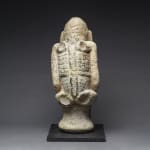Taino Stone Zemi Sculpture, 1100 CE - 1500 CE
Stone
52.1 x 27.9 cm
20 1/2 x 11 in
20 1/2 x 11 in
FF.057
Further images
A zemi was the physical manifestation of a Taino god, spirit or ancestor. Zemi images were carved in a variety of materials including wood and shell, but the most impressive...
A zemi was the physical manifestation of a Taino god, spirit or ancestor. Zemi images were carved in a variety of materials including wood and shell, but the most impressive depictions were carved from a dense, veined stone. This example is exceptional for a number of reasons. Unusually the figure is seated on a high stool which was a mark of status in Taino society. Ceremonial seats, called duhos, were only allocated to the most distinguished guests at religious ceremonies or ball-games. Seated leaning forward, with his hands resting on his knees and his back hunched, this pose probably reflects that assumed by Taino shamans during the cohoba rituals. Alternatively it might represent a Taino chieftain (cacique), many of whom were deified after death and venerated by their successors. The figure is naked except for elaborate jewelry worn around the upper arms and legs. The reverse is an artistic tour-de-force, with the spinal cord, shoulder-blades and rib-cage all clearly delineated. The headdress is equally impressive, carved with geometric motifs which must have had some cosmological significance for the Taino. The facial features are also distinctive; rather than the deeply carved circular orbits and wide open mouth evident on other zemi sculptures, the eyes and mouth are both closed.
To western sensibilities there is an obvious contradiction between the figure’s skeletal form, suggestive of death and decay, and the phallus visible between the knees. The latter is clearly a symbol of potency and fertility that seems oddly juxtaposed with bodily indicators of old age. However it was not unusual in the New World to combine such iconography. Parallels have been drawn with the pottery vessels from the ancient Moche civilization of Peru, which depict well-built women in the company of skeletal males with erect phalluses. As Peter Roe has argued, ‘In the New World, the iconography of mortality was linked to images of fecundity.’
A carving of this complexity and size must have belonged to a chieftain or member of his retinue. Although the Taino left no written records, the Spanish settlers recorded native practices. One eye-witness refers to special structures or temples in which the chieftains stored their zemi carvings. The Taino believed in the existence of an afterlife and the ability of shamans to communicate with the dead. This sculpture may well have been a prop in such a ceremony, or a focus for ancestor worship. This is a remarkably evocative work that allows us to glimpse some of the splendours of Taino civilization. (AM)
To western sensibilities there is an obvious contradiction between the figure’s skeletal form, suggestive of death and decay, and the phallus visible between the knees. The latter is clearly a symbol of potency and fertility that seems oddly juxtaposed with bodily indicators of old age. However it was not unusual in the New World to combine such iconography. Parallels have been drawn with the pottery vessels from the ancient Moche civilization of Peru, which depict well-built women in the company of skeletal males with erect phalluses. As Peter Roe has argued, ‘In the New World, the iconography of mortality was linked to images of fecundity.’
A carving of this complexity and size must have belonged to a chieftain or member of his retinue. Although the Taino left no written records, the Spanish settlers recorded native practices. One eye-witness refers to special structures or temples in which the chieftains stored their zemi carvings. The Taino believed in the existence of an afterlife and the ability of shamans to communicate with the dead. This sculpture may well have been a prop in such a ceremony, or a focus for ancestor worship. This is a remarkably evocative work that allows us to glimpse some of the splendours of Taino civilization. (AM)





